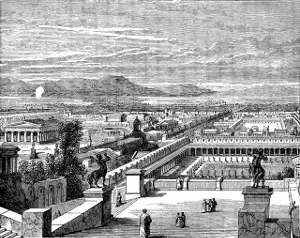Corinth: Ancient Greek Powerhouse of Trade and Culture
Corinth was one of the wealthiest cities in the ancient Greek world. Its prime location–on the Isthmus of Corinth, in the middle of the Greek lands, surrounded by fertile plains and natural springs, and boasting two seaports–made it a prime destination for traders. Corinth held such sway that it developed its own coinage and required traders to use it as currency. One main geographical feature of the city of Corinth was the diolkos (Greek for "haul across"), a paved roadway that connected the two gulf, allowing the quick transport of goods and even boats. 
The city of Corinth is also famous for a style of architecture that includes the city's name. The Doric and the Ionic are two forms of architecture used in Ancient Greek; it was the Corinthian style, however, that was the most ornate and the most famous. Corinth was also well-known for its distinctive pottery. Corinth was also a center for Greek myths, among them that of Sisyphus, Pegasus, Theseus, and Jason (of Argonaut fame) and his wife, Medea. Corinth began as a small settlement; as it grew, a line of kings assumed command and ruled for a time. A father and son pair of tyrants, Cypselus and Periander, ruled Corinth for 70 years, beginning in 657 B.C. A group of oligarchs, 80 strong, took control in 585 and ruled as a council for many years. Corinthian forces are also said to have served under the lead of Agamemnon during the Trojan War. Corinth joined Athens and other cities in successfully resisting the Persian forces of Xerxes. Corinth took the side of Sparta in the Peloponnesian War and kept Athens from seizing control of Syracuse, Corinth's main colony. Other Corinthian colonies included Corcyra and Epidamnus. In part because of Sparta's refusal to raze Athens and in part because of its own fear of Spartan influence, Corinth joined with Athens, along with Argos and Thebes, to fight against Sparta. These were the Corinthian Wars, which lasted 11 years, ending in a victory for Sparta in 386 B.C. When Philip II of Macedon arrived at the head of a large army, Corinth stood up and resisted, as did other cities. Philip's victory at Chaeronea in 338 reduced Corinth to a protectorate. Corinth later joined the Achaean League. Rome was not at all forgiving and sacked the city, at the direction of Commander Lucius Mummius, in 146 B.C. Another, more famous commander, Julius Caesar, arrived in 44 B.C. and founded a colony. The industrious Caesar set about organizing the farmland into consistent plots, to maximize farming efficiency, and Corinth made a relatively rapid return to the status of trade center. Corinth is also known, according the Greek historian Thucydides, as the birthplace of the trireme, the warship that became standard issue for Mediterranean powers for generations. Corinth and Corcyra, according to Thucydides, fought the first naval battle ever recorded, in 665 B.C. (Corinth won.) The Isthmian Games, named for the Isthmus of Corinth, took place the year before and the year after the Olympic Games, beginning in the 6th Century B.C. On offer at the Isthmian Games were competition in boxing, chariot racing, pankration, and wrestling. All of those were for men only; open to both genders were music and poetry contests. Corinth, it was said, was home to Diogenes, a philosopher famed for living in a barrel. As the story goes, Alexander the Great approached Diogenes and asked if he wanted anything. "Could you move," came the reply. "You're keeping the Sun off me." Another famous resident of Corinth for a time was the Christian Apostle Paul, who wrote many of the books of the Christian Bible's New Testament, including two letters to the Corinthians. |
|
Social Studies for Kids
copyright 2002–2024
David White




